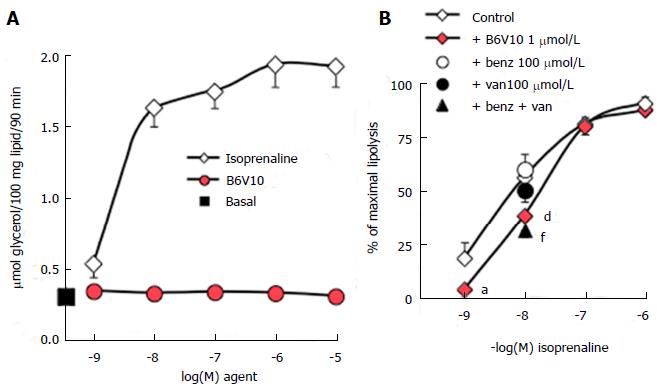Copyright
©The Author(s) 2017.
World J Diabetes. Apr 15, 2017; 8(4): 143-153
Published online Apr 15, 2017. doi: 10.4239/wjd.v8.i4.143
Published online Apr 15, 2017. doi: 10.4239/wjd.v8.i4.143
Figure 2 Influence of B6V10 on basal and isoprenaline-stimulated lipolysis in mouse adipocytes.
Glycerol release was determined after 90-min incubation of mouse fat cells without (basal, closed square) or with the indicated concentrations of isoprenaline (open diamonds) or B6V10 (red symbols). A: Lack of lipolytic effect of increasing doses of B6V10 (red circles); B: Comparison of the inhibition of isoprenaline-stimulated lipolysis by 1 μmol/L B6V10 (red diamonds), 0.1 mmol/L benzylamine (open circle), 0.1 mmol/L vanadate (closed circle), or their combination (closed triangle). Mean ± SEM of 8 determinations. Significantly different from corresponding control at: aP < 0.05, dP < 0.01, fP < 0.001.
- Citation: Carpéné C, Garcia-Vicente S, Serrano M, Marti L, Belles C, Royo M, Galitzky J, Zorzano A, Testar X. Insulin-mimetic compound hexaquis (benzylammonium) decavanadate is antilipolytic in human fat cells. World J Diabetes 2017; 8(4): 143-153
- URL: https://www.wjgnet.com/1948-9358/full/v8/i4/143.htm
- DOI: https://dx.doi.org/10.4239/wjd.v8.i4.143









